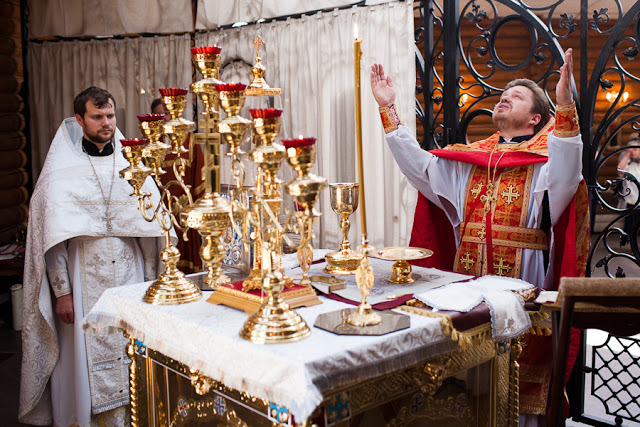
Next in this commentary series we examine the Anaphora, which is a Greek word meaning “offering” (the verb form is used in Leviticus 17:5, for example, where it describes the offering of sacrifice). It is a long prayer, punctuated by a number of “Amens”. It begins with the celebrant’s blessing “The grace of our Lord Jesus Christ, and the love of God the Father, and the communion of the Holy Spirit be with you all” and does not conclude until the end of the words, “and grant that with one mouth and one heart we may praise Your all-honourable and majestic name: of the Father and of the Son and of the Holy Spirit, now and ever and unto ages of ages”. The congregational “Amen” which follows seals the entirety of the long anaphoral prayer. It is sometimes referred to as “the Eucharistic prayer”, since it constitutes the heart of the Eucharist and serves to consecrate the gifts of bread and wine, transforming them by the Spirit’s power into the Body and Blood
of the Lord. A Eucharist can do without the antiphons if need be, or even without the Creed, but not without the Anaphora, for it is this prayer which makes the Eucharist to be the Eucharist. We may look at three of its characteristics, for they reveal something about who we are as Orthodox Christians and how we are to live.
of the Lord. A Eucharist can do without the antiphons if need be, or even without the Creed, but not without the Anaphora, for it is this prayer which makes the Eucharist to be the Eucharist. We may look at three of its characteristics, for they reveal something about who we are as Orthodox Christians and how we are to live.
First the prayer is dialogic. That is, it begins not with words addressed to God but with a dialogue in which the celebrant and the congregation address each other. The long prayer is prefaced with this back and forth: the priest first blesses the congregation in the name of the Triune God (in the words cited above), and they respond by blessing him in return: “And with your spirit!” He then tells them, “Lift up your hearts!”, and they respond, “We lift them up unto the Lord!” In this second exchange he is not urging them to cheer up, encouraged possibly by the fact that the end of the long service draws near, but telling them to ascend. The Lord reigns in heaven, and in the Liturgy we ascend to where He reigns. Our Liturgy in St. Herman’s therefore is not served in Langley, but in the Kingdom; not on earth, but in heaven. In the Liturgy time and eternity intersect, and heaven meets earth. We serve and worship with the Mother of God, the saints, and the angels, for we ascend to where they are. In a final exchange the priest says, “Let us give thanks unto the Lord”, and the people respond, “It is meet and right”. The meaning of this last exchange is easily missed: the priest is obtaining the liturgical assent of the gathered community to offer the Eucharist, for it is as part of that assembly that he speaks and acts. It is his signal to proceed with the anaphoral prayer.
It is not just in the opening preface that we find congregational response. Throughout the anaphora the congregational voice is heard, joining the priest, finishing his sentences. Thus, for example, when he rejoices in the heavenly song of the angels and says that they are “singing the triumphant hymn, shouting, proclaiming, and saying” the congregation joins in and completes his sentence: “Holy! Holy! Holy! Lord of Sabaoth! Heaven and earth are full of Your glory! Hosanna in the highest!” And again, when the priest says, “Your own of Your own we offer unto You, on behalf of all and for all”, the people again join him, saying, “We praise You! We bless You! We give thanks unto You, O Lord!” It is as if they are so enthusiastic they cannot keep themselves from joining in. Yet these congregational interruptions do not reveal only their liturgical exuberance, but also their sacramental status. They join in with the priest because they are the royal priesthood, the body of the high-priest Jesus Christ, and it is this corporate priesthood to which the celebrant gives voice. Their dialogic participation reveals that they are not simply passive observers, but active offerers; not an audience, but a priesthood, not the great unwashed, but the holy people of God, made holy through the washing of holy baptism.

Secondly, the anaphora is an anamnesis, a word sometimes rendered “remembrance”. Thus in the Authorized King James Version of Luke 22:19 we read that Christ said, “This is My body which is given for you; this do in remembrance of Me”. Such a translation can be a bit misleading, for we often tend to think of remembering in terms of mental activity—I can daydream about the future or remember the past, but in both cases words describe a purely cerebral happening taking place inside my head. The word anamnesis is less misleadingly rendered as “memorial”, and in Hebrew thought a memorial is not a merely mental process but an action that is done. Thus in Numbers 10:1f, Moses was commanded to make two silver trumpets which were to be blown over their sacrifices in times of war, and “there shall be a memorial for you before your God” (v. 10). In other words, when the trumpets are blown over the sacrifices, they will “be remembered before the Lord your God and you shall be saved from your enemies” (v. 9). In this memorial, it is God who does the remembering. And God’s remembering here is also not a purely mental act, but means that God takes action and saves. That is the point of Christ’s words at the mystical Last Supper: the act of eating bread and drinking wine during their gathered assembly is Christ’s memorial, the means whereby God remembers Christ and His sacrifice and take action to save us. Through this memorial, Christ’s saving sacrifice becomes present and active in our midst. The bread which we eat as His memorial is His sacrifice, His true Body, and the cup from which we drink is His Blood. That is why the liturgical tradition everywhere speaks of the Eucharist as a bloodless sacrifice—it is not a fresh immolation of Christ, or a re-crucifixion, but an anamnesis of His once-for-all offered sacrifice. There is no salvation without the Cross, and the Cross is not sacramentally saving in our weekly lives without the Eucharist. We are saved by His sacrifice, since we are the people of the Eucharist.
This means that the Eucharist is the most important thing we ever do, and we live from Eucharist to Eucharist, even as we live from breath to breath. Without the Eucharist, we have no life. One remembers the story recounted long ago by Gregory Dix in his classic The Shape of the Liturgy, about the importance of the Eucharist in the early church: “A whole congregation of obscure provincials at Abilinitina in Africa took the risk of almost certain detection by assembling at the height of the Diocletian persecution in their town, where the authorities were on the watch for them, because, as they said in court, the eucharist had been lacking a long while through the apostasy of their bishop Fundanus and they could no longer bear the lack of it. And so they called on a presbyter to celebrate—and paid the penalty of their faith down to the last man.” The story reveals not only the courage of these obscure Christians, but also the importance of the Eucharist for all of us even today.
Finally the anaphora is an extended epiclesis or invocation of the Spirit. The epicletic character of the entire prayer is summed up most succinctly in so-called epiclesis itself, in which the celebrant asks God to send down His Spirit upon the offering. But we must look more carefully upon the actual wording, for the Spirit is not simply invoked upon the gifts of bread and wine alone, but also upon us as well. Thus the celebrant prays, “Send down Your Holy Spirit upon us and upon these gifts here offered and make this bread the precious body of Your Christ and that which is in this cup the precious blood of Your Christ, making the change by Your Holy Spirit.” Note: “Send down Your Holy Spirit upon us and upon these gifts”. The final goal of the epiclesis and of the anaphora and the Eucharist as a whole is not to merely change the bread into the body of Christ, but also to change us into His body. Through eating the sacramental Body of Christ, we are incorporated afresh into Him as His mystical Body. The goal is not simply the transformation of the gifts, but our own transformation as well. Regarding the transformation of the Gifts of bread and wine into Christ’s Body and Blood, St. Cyril of Jerusalem once said, “Whatever the Holy Spirit has touched is sanctified and changed”. He might have said this about us also, for the goal of the Eucharist is to sanctify and change us as well. We walk into the church guilty, stained, weighed down with sins and heavy laden; we walk out of the Church after receiving the Eucharist forgiven, cleansed, liberated and light.
The Anaphora is the heart of the Divine Liturgy, for it is our liturgical thanksgiving. It reveals us as the holy people God, baptized so that we may declare the wonders of Him who called us out of darkness into His marvellous light (1 Peter 2:9).




